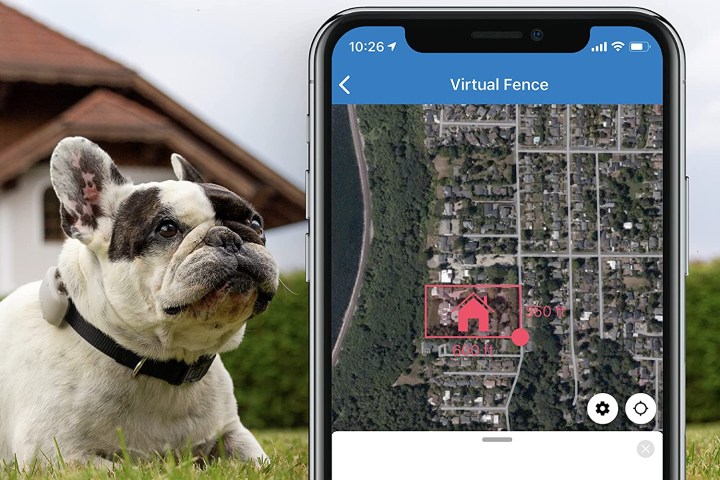It’s National Pet Week, and at Digital Trends, we know how to celebrate — with a plethora of the smartest gadgets for our beloved pets. But we also want to ask an important question: Is that tech always a good thing?
Pet tech promises plenty of advantages, especially when it comes to watching over pets from afar. Apps, sensors, and trackers abound. But ultimately, how healthy is that for our pets? Is there a point where too much technology just isn’t good for our furry companions? Can it stress them out, cause behavioral issues, or even worse problems?
There aren’t always answers, but it’s still a good idea to ask. Let’s take a look at what we know about smart pet tech, who it’s really for, and how pets interact with it.

Pet owner FOMO
One of the most popular smart tech picks for pet owners is a pet cam. We’ve got a whole list of them, all ready to keep an eye on your pet around the house. But here’s caveat for pet cams: They’re designed for the owner, not the pet.
Pets will largely do the same things around the house during the day regardless of whether or not there’s a cam there. Two-way audio options may or may not have any effect on our furry friends, because many pets just can’t distinguish sound coming from speakers the same way they can with real-life voices. The real motivation behind pet cams is owner FOMO — busy pet lovers in fear of missing out on what their pets are doing throughout the day and may feel a little guilty about leaving their buddies at home while they work or go on vacation. We’ve all been there.
Let’s not forget the privacy issues with having on-demand cam devices around your home, something that gives pause to those without paws.
In this light, all the smart pet cam features depend on what we, not our pets, want from the device. Would you like the ability to capture a quick video of your pet attacking a shadow and post it on social media? No problem! But we shouldn’t pretend our pet will care much either way. The best result of pet cams is that your pet learns when the weird box is making noises at them and comes to investigate — but they aren’t the ones missing out.
Finally, let’s not forget the privacy issues with having on-demand cam devices around your home, something that gives pause to those without paws, especially when it’s not always certain how pet brands are encrypting or using that video data.

Who is the treat really for?
Pet cam and pet monitoring creators were quick to realize that owners could benefit from additional ways to interact with their pets from a distance. That birthed an infamous new feature: Treat launchers. Today’s pet cams and other monitoring devices come with the ability to launch a treat on demand, right from your monitoring app.
While this may give us a thrill of happiness to see video feeds of our pets scampering after treats (along with the satisfaction from knowing we care that much), the pet-based value is more dubious.
The more obsessed owners become with launching treats while they can’t interact with their pet directly, the more danger that their pet will become overweight from the practice. There’s no added benefit, either, as there is with providing treats during training for a job well done. At most, owners will train their pets to pay more attention to a pet cam than to a real person when they want a treat, which is far from healthy behavior.
But treat launchers still sell, because they’re cool and they make us feel good. The trick humans have to learn is knowing when treat launchers cross a line and become harmful for the pets we want to delight.

Counting electric squirrels
There is another tech fad for pet owners (you may already be thinking about it) who can’t be at home with their pets during the day — slapping on a TV show or app that they’ll enjoy. Apps like Netflix are packed with nature shows featuring all kinds of scurrying animals our pets may enjoy watching, and many pets are smart enough to recognize what’s happening on the screen and be fascinated by it. Just ask dog owners how much their furry friends like watching TV with them. There’s even a DogTV network with several-minute “shows” designed to mimic common dog play or household activity.
Apps and games are the same: The first Cat Fishing app for iPad and iPhone was so popular that Nestle made Cat Fishing 2. Dozens of other apps followed, promising to fascinate and engage pets who otherwise wouldn’t have anything to do.
It’s a classic babysitting dilemma. Sure, a nature show or mouse-hunting app may not be the healthiest kind of entertainment, but it keeps them distracted, and isn’t it better than them growing bored and destructive?
Experts are divided. Pulling up a video for pets isn’t like handing toddlers a tablet, and we aren’t entirely sure what the long-term effects are. Some vets have expressed worry that TV could take the place of otherwise healthy exercise. Others mention that enjoyable TV action could be a solution to separation anxiety when pet owners have to leave for the day, a bit like white noise when we’re trying to sleep. Or perhaps muted DogTV samples of vacuum cleaners and toddlers can help train pets to not be afraid of the real version. Of course, other experts caution that pets may not really understand what’s going on in a show or app at all. And when it comes to predators like cats, there’s an additional concern that games like Cat Fishing are ultimately frustrating, because there’s no final kill — no ultimate bite or toss that a cat instinctually needs to feel like the hunt is complete.
As we know all too well, TV isn’t exactly a solution to boredom, and may not keep your shoes from getting chewed no matter how many squirrels are scampering across the screen. But in moderation, digital play may help reduce stress, perk up pet moods, and even improve relationships with owners, especially if there’s an interactive element.
For pets who just have too much energy in the day, TV probably isn’t a good choice. Instead, there are smart toys to help engage them, from puzzle toys that encourage play to smart bones that you can bounce via an app even if you aren’t at home. And maybe that’s some extra pet-based value for your pet cam, too.

What pets don’t know can hurt them
While it would be nice, our pets can’t check an owner’s manual to see if they are using smart devices correctly. The problem is that using devices incorrectly can sometimes be bad for their health.
The worst example is built-in laser pointers on pet devices. These laser points can be activated from an app or switched to an autoplay mode to provide rigorous entertainment when owners can’t be there. It’s fun in theory, but can be dangerous in practice: Eyes can be damaged if we look directly at a laser pointer, and pets are no exception. There’s also no warning we can give inquisitive pets to stop investigating the device producing the laser pointer, which could lead to accidental eye injuries.
Problems can also crop up with automated pet feeders. While these can be used for portion control for pets who need to lose weight, not all pets react the same. The pet-centric internet is packed with meme videos about pets confused or clawing at their feeders, clearly increasing their stress levels and causing high levels of frustration. At the worst, they may attack feeders and injure themselves or gnaw off plastic, which can cause additional health concerns.
Dangers like these are why, ultimately, smart pet devices’ benefits vary on a case-by-case basis. It’s hard to tell how your own buddy will react, and difficult to test ahead of time. That creates a built-in risk when purchasing pet tech, and as owners we need to be aware that one size won’t fit all.

Where humans benefit from smart tech, pets usually do too
We’ve spent time looking at the dark side of smart pet tech, but we’ll end on a positive note: Certain kinds of smart pet devices are excellent for health-focused outcomes. And in many cases, it’s the same kind of smart tech that helps humans monitor and reach their own health-based goals.
Pet activity monitors, for example, are very similar to smart health trackers and gym equipment that humans use, allowing owners to see just how active their pets are throughout the day. And like human health apps, you can set goals for your pet to get a certain amount of exercise or burn a certain amount of calories a day. The monitors can also function like our smart sleep trackers, showing how restless pets are in the night and how much they may be struggling to sleep. Even activity monitoring on litter boxes can show how often your cat is using it and if they may be struggling with a UTI or similar condition.
Pet activity monitors are often a part of pet-tracking devices, another advantage that’s similar to smart trackers we use for other purposes. Snap a little box to your pet’s collar, and suddenly you can track whenever they escape the house or jump the fence — not many downsides there. More advanced versions can help pinpoint lost pets wherever they are, or help you find new jogging routes that your pup hasn’t explored yet.
Ultimately, from health tracking to TV, the best guidance we have for safe smart tech is often what works for humans.



